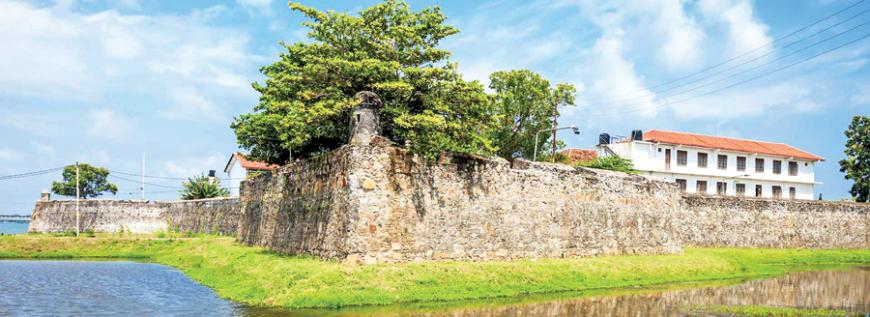
The coastal city, which is surrounded by a muddy lagoon, got the name Madakalapuwa which is the present-day Batticaloa. The Dutch Fort in Batticaloa, which is still in use, stands out as the main monument which reflects the city’s past.
In 1505, under the leadership of Lorenzo de Almeida, the Portuguese accidentally landed in Ceylon. In a short time, the Portuguese managed to gain control over all the shipping ports around Ceylon. They were interested in building naval Forts centered on cities. They also built a Fort in Batticaloa in 1628. Gravel, clay and wood had been used in building the Fort, which is in the Puliyanthivu Island in Batticaloa.
It is said that this island was separated from the main island before European nations arrived in the country. Those who lived on the main island maintained their relationships with those who lived on this island by the use of small boats. It is said that the people visiting the island park their boats at a certain place which is now referred to as the “Batticaloa Gate”. Anchoring ships
Portuguese captain
Joao Ribeiro, a Portuguese captain, describes the condition of the Fort at that time, “The Batticaloa Fort is situated on a point of land, which was an ideal place for anchoring ships. Twenty-four leagues from here the coast stretches like a tongue from South to North, its end near the Fort of Trincomalee. Batticaloa Fort is a safe place.”
 “It is an old fashioned square structure with four attics. It had a captain and 50 soldiers, a constable, and 20 natives, along with a dozen iron cannons. There was also a church and a warehouse and ammunition depot.”
“It is an old fashioned square structure with four attics. It had a captain and 50 soldiers, a constable, and 20 natives, along with a dozen iron cannons. There was also a church and a warehouse and ammunition depot.”
It has also been revealed that there was a Buddhist temple here before the construction of the Fort due to the discovery of a “chhatra” stone and a granite seat belonging to a stupa. The ground plan of the Fort takes the shape of a cross. Being located on an island, its security was confirmed. It consisted of three guardhouses during the Portuguese period. Artillery and troops were stationed at each watch tower. It is said that there were 11 brass and iron cannons for its protection. It also had military quarters, warehouses and a church.
The Dutch defeated the Portuguese and captured the Fort in 1638. The Dutch work was based on an agreement with King Rajasingha II. A Dutch pastor describes the situation at that time, “Batticaloa Fort, which was in an area about two Dutch miles in size, was located three miles inland from the river. The Fort had high granite walls. It was built of 300 stones and armed with five brass and iron cannons and several other guns. There was also gunpowder, lead and ammunition. The stock of rice stored there was enough for two months. But getting drinking water was quite difficult.
After the Fort was taken over by the Dutch, it was enlarged and rebuilt to ensure its security. The walls were enlarged and four guardhouses were built. There is evidence that there were two towers. There were 12 cannons each in the Columbus watch tower and the Harlem watchtower, and 10 each in the Amsterdam and Gaul towers.
Amsterdam attic
The Dutch flag was also raised in the Amsterdam attic. The year 1682 is written on a triangular granite slab above the entrance. It can be seen that it was the year when the Fort was renovated. In front of the entrance was the jetty where the boats coming from the lagoon parked. A warehouse had been built near the jetty.
In 1796, the British acquired the ownership of the coastal provinces of Ceylon from the Dutch. They changed the buildings in the Fort and converted them into administrative offices. The warehouse building was converted into a two-storeyed building with a vestibule and turned into the office of the Governor. Two rooms in the Amsterdam guardhouse are visible even today and remain without use. Some modern buildings have also been built in the Fort.
The moat around the Fort has hindered the appearance of the Fort due to lack of proper maintenance. The wall can be seen in its ancient form. Batticaloa is the only Fort with a fully supported cannon, which is still active.
When one climbs on top of this, he or she can see the lagoon, Batticaloa city and the Kalladi Bridge. Many Government offices including the Batticaloa District Secretariat and the Museum are still in the Fort. A separate space has been reserved for the tourists who visit the Fort.
